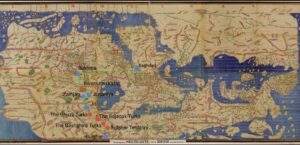Month: April 2022 (Page 5 of 8)

Ibn Fadlan’s journey approximated on the Charta Rogeriana.
When I transferred my modern map onto the Hereford Mappamundi, there were many noticeable differences between the two maps. Firstly, the modern map showed accurate terrain and distances between locations, making it easier to understand how long it would take to travel from place to place. The medieval map is a T-O map so it is oriented with Asia at the top. There is no concept of true distance on the medieval map. Since the continents are not accurate in shape or size, the locations Margery traveled to are more abstract and you have to estimate where they would be. There is also a more detail about people that Margery may encounter on her journey, but no details on the terrain. The modern map has lines of latitude and longitude, making it easy to plot points accurately. Additionally, the modern map has many more detailed locations on it whereas the medieval map has set locations. To plot all of the points takes some estimation when the cities are not on the map.
Additionally, on the medieval map is oriented with north to the left and Jerusalem at the center of the map. The modern map which I detailed Margery’s journey on doesn’t have a center because the viewer can orient the map however they wish with the digital viewing technology. Although, it is worth pointing out that most modern maps have Europe at the center- indicating a Euro-centric ideology because Europe is centered in the middle. Similarly, for the Medieval map, Jerusalem is in the center of the map. Clearly, Jerusalem is oriented as the center of the world, emphasizing the importance of Jerusalem in the Christian World. The medieval map also includes other religious locations like the Garden of Eden, located at the very top of the map, clearly indicating that this map was drawn with Christianity as the focus. The modern map, however, is geographically accurate, with no religious motivations at all.
The modern map is in English, making it very easy to locate the ten locations. However, the medieval map is in Norman French and the writing is barely decipherable. Even if I could see the writing, I wouldn’t be able to understand the language. I used the Hereford Map website to help me place my initial locations (Rome, Jerusalem, and Venice). I then estimated where the other locations would be based on a modern map, estimating proximity and location.
The Hereford Mappamundi would be virtually useless to a traveler like Margery, unlike the modern map. The medieval map offers no real references for time and distance, and is not even an accurate representation of the shapes and and continents. Actually using a map like the Hereford map would lead to a very confusing journey, because there is no indication of distance and terrain. Traveling with a map, or even looking at it before the journey, would offer very little, if any, insight into how long and what the journey would look like. Additionally, the Mediterranean is incredibly inaccurate, making it impossible to plan for a sea voyage.
